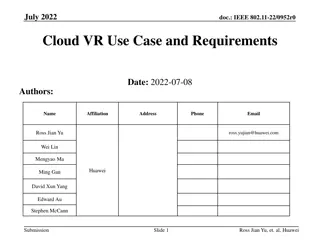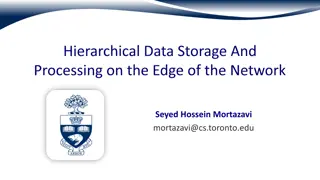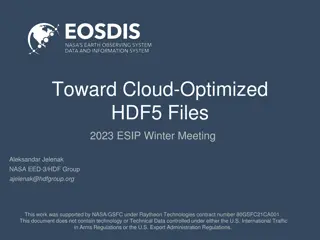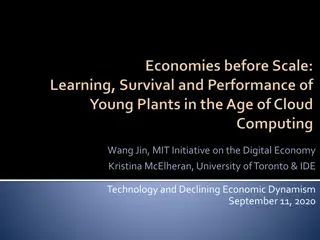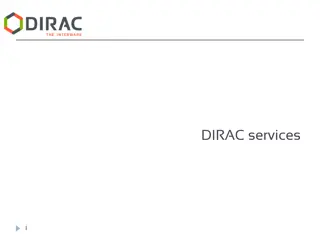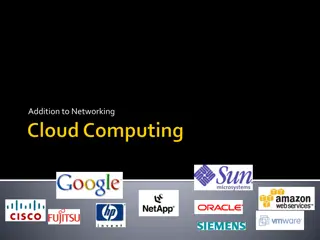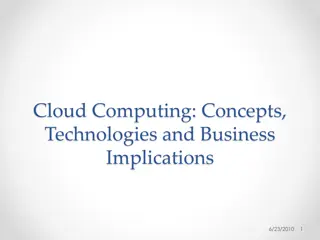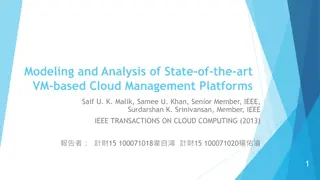Overlay Network Idea and ACID Model in Cloud Computing
This content discusses the overlay network idea in cloud computing, focusing on key-value storage systems like Dynamo and Chord. It also delves into the challenges of ensuring consistency in data updates and reads in cloud systems, touching upon the ACID model for databases.
Download Presentation

Please find below an Image/Link to download the presentation.
The content on the website is provided AS IS for your information and personal use only. It may not be sold, licensed, or shared on other websites without obtaining consent from the author.If you encounter any issues during the download, it is possible that the publisher has removed the file from their server.
You are allowed to download the files provided on this website for personal or commercial use, subject to the condition that they are used lawfully. All files are the property of their respective owners.
The content on the website is provided AS IS for your information and personal use only. It may not be sold, licensed, or shared on other websites without obtaining consent from the author.
E N D
Presentation Transcript
CS5412 Spring 2016 (Cloud Computing: Birman) 1 CS5412: THE BASE METHODOLOGY VERSUS THE ACID MODEL IN AN OVERLAY Lecture IX Ken Birman
Recall the overlay network idea 2 For example, Dynamo, Chord, etc Basically, a key-value storage system spread over a big pool of nodes inside Facebook or some other cloud platform. Lookups are fast (1-hop if you have a list of the nodes in the DHT, as they do at Facebook or Amazon or Google). Very popular and important, used extensively in the cloud. Perhaps the single most important enabler for scalability in today s cloud systems! CS5412 Spring 2016 (Cloud Computing: Birman)
Question well focus on today 3 Suppose that one application does a put to store something in the DHT For example, it stores a new profile picture for Ken Will some other application be sure to see the new version if it issues a subsequent get ? Sounds reasonable, but some form of locking would be required to implement this behavior We ll see that this is an issue in today s cloud and in fact the prevailing approach just says no to locking! CS5412 Spring 2016 (Cloud Computing: Birman)
More general version of this question 4 Those of you taking Al Demers course will be thinking about massive databases They also have a model focused on updates and reads and the same issue arises in transactional applications So: should the cloud try to be transactional in these giant, super-fast key-value storage structures? CS5412 Spring 2016 (Cloud Computing: Birman)
Methodology versus model? 5 Today s lecture is about an apples and oranges debate that has gripped the cloud community A methodology is a way of doing something For example, there is a methodology for starting fires without matches using flint and other materials A model is really a mathematical construction We give a set of definitions (i.e. fault-tolerance) Provide protocols that provably satisfy the definitions Properties of model, hopefully, translate to application-level guarantees CS5412 Spring 2016 (Cloud Computing: Birman)
The ACID model 6 A model for correct behavior of databases Based on the concept of transaction A transaction is a sequence of operations on database or data store that form a single unit of work. Operations: reads or writes A transaction transforms a database from one consistent state to another During execution the database may be inconsistent All operations must succeed; otherwise transaction fails CS5412 Spring 2016 (Cloud Computing: Birman)
ACID as a methodology Body of the transaction performs reads and writes, sometimes called queries and updates 7 We teach it all the time in our database courses Students write transactional code Begin let employee t = Emp.Record( Tony ); t.status = retired ; customer c: c.AccountRep== Tony c.AccountRep = Sally Commit; Begin signals the start of the transaction Commit asks the database to make the effects permanent. If a crash happens before this, or if the code executes Abort, the transaction rolls back and leaves no trace System executes this code in an all-or-nothing way CS5412 Spring 2016 (Cloud Computing: Birman)
ACID model properties 8 Issues: Concurrent execution of multiple transactions Recovery from failure Name was coined (no surprise) in California in 60 s Atomicity: Either all operations of the transaction are properly reflected in the database (commit) or none of them are (abort). Consistency: If the database is in a consistent state before the start of a transaction it will be in a consistent state after its completion. Isolation: Effects of ongoing transactions are not visible to transaction executed concurrently. Basically says we ll hide any concurrency Durability: Once a transaction commits, updates can t be lost or rolled back CS5412 Spring 2016 (Cloud Computing: Birman)
ACID example 9 Transaction to transfer $10000 from account A to account B: 1. read(A) 2. A := A 10000 3. write(A) 4. read(B) 5. B := B + 10000 6. write(B) Consistency requirement the sum of A and B is unchanged by the execution of the transaction. Atomicity requirement if the transaction fails after step 3 and before step 6, the system should ensure that its updates are not reflected in the database, else an inconsistency will result. CS5412 Spring 2016 (Cloud Computing: Birman)
ACID example continued 10 Durability requirement once the user has been notified that the transaction has completed (i.e., the transfer of the $10000 has taken place), the updates to the database by the transaction must persist despite failures. Isolation requirement if between steps 3 and 6, another transaction is allowed to access the partially updated database, it will see an inconsistent database (the sum A + B will be less than it should be). Can be ensured trivially by running transactions serially, that is one after the other. However, executing multiple transactions concurrently has significant benefits, as we will see. CS5412 Spring 2016 (Cloud Computing: Birman)
Why ACID is helpful 11 Developer doesn t need to worry about a transaction leaving some sort of partial state For example, showing Tony as retired and yet leaving some customer accounts with him as the account rep Similarly, a transaction can t glimpse a partially completed state of some concurrent transaction Eliminates worry about transient database inconsistency that might cause a transaction to crash Analogous situation: thread A is updating a linked list and thread B tries to scan the list while A is running CS5412 Spring 2016 (Cloud Computing: Birman)
Implementation considerations 12 Atomicity and Durability: Shadow-paging (copy-on-write): updates are applied to a partial copy of the database, the new copy is activated when the transaction commits. Write-ahead logging (in-place): all modifications are written to a log before they are applied. After crash: go to the latest checkpoint, replay log. CS5412 Spring 2016 (Cloud Computing: Birman)
Implementation considerations 13 Isolation: Concurrency control mechanisms: determine the interaction between concurrent transactions. Various levels: Serializability Repeatable reads Read committed Read uncommitted CS5412 Spring 2016 (Cloud Computing: Birman)
ACID another example 14 Imagine the following set of transactions: T0: Employee.Create("Sally", "Intern", Intern.BaseSalary); T1: Sally.salary = Sally.salary*1.05% T2: Sally.Title =" Supervisor"; Sally.Salary = Supervisor.BaseSalary; T3: Print(SUM(e.Salary where e.Title="Intern")/ Count(e WHERE e.Title == "Intern")); Print(SUM(e.Salary where e.Title="Supervisor")/ Count(e WHERE e.Title == "Supervisor")) CS5412 Spring 2016 (Cloud Computing: Birman)
ACID another example 15 What happens if order changes: T0, T1, T2, T3 vs. T0, T2, T1, T3 vs. T0, T3, T1, T2 Which outcome is correct ? Is there a case where multiple outcomes are valid? What ordering rule needs to be respected for the system to be an ACID database? CS5412 Spring 2016 (Cloud Computing: Birman)
Serial and Serializable executions 16 A serial execution is one in which there is at most one transaction running at a time, and it always completes via commit or abort before another starts Serializability is the illusion of a serial execution Transactions execute concurrently and their operations interleave at the level of the database files Yet database is designed to guarantee an outcome identical to some serial execution: it masks concurrency In past they used locking; these days snapshot isolation Will revisit this topic in April and see how they do it CS5412 Spring 2016 (Cloud Computing: Birman)
Implementation considerations 17 Consistency: A state is consistent if there is no violation of any integrity constraints Consistency is expressed as predicates data which serves as a precondition, post-condition, and transformation condition on any transaction Application specific Developer s responsibility CS5412 Spring 2016 (Cloud Computing: Birman)
All ACID implementations have costs 18 Locking mechanisms involve competing for locks and there are overheads associated with how long they are held and how they are released at Commit Snapshot isolation mechanisms using locking for updates but also have an additional version based way of handing reads Forces database to keep a history of each data item As a transaction executes, picks the versions of each item on which it will run So there are costs, not so small CS5412 Spring 2016 (Cloud Computing: Birman)
Dangers of Replication [The Dangers of Replication and a Solution . Jim Gray, Pat Helland, Dennis Shasha. Proc. 1996 ACM SIGMOD.] 19 Investigated the costs of transactional ACID model on replicated data in typical settings Found two cases Embarrassingly easy ones: transactions that don t conflict at all (like Facebook updates by a single owner to a page that others might read but never change) Conflict-prone ones: transactions that sometimes interfere and in which replicas could be left in conflicting states if care isn t taken to order the updates Scalability for the latter case will be terrible Solutions they recommend involve sharding and coding transactions to favor the first case CS5412 Spring 2016 (Cloud Computing: Birman)
Approach? 20 They do a paper-and-pencil analysis Estimate how much work will be done as transactions execute, roll-back Count costs associated with doing/undoing operations and also delays due to lock conflicts that force waits Show that even under very optimistic assumptions slowdown will be O(n2) in size of replica set (shard) If approach is na ve, O(n5) slowdown is possible! CS5412 Spring 2016 (Cloud Computing: Birman)
This motivates BASE [D. Pritchett. BASE: An Acid Alternative. ACM Queue, July 28, 2008.] 21 Proposed by eBay researchers Found that many eBay employees came from transactional database backgrounds and were used to the transactional style of thinking But the resulting applications didn t scale well and performed poorly on their cloud infrastructure Goal was to guide that kind of programmer to a cloud solution that performs much better BASE reflects experience with real cloud applications Opposite of ACID CS5412 Spring 2016 (Cloud Computing: Birman)
A methodology 22 BASE involves step-by-step transformation of a transactional application into one that will be far more concurrent and less rigid But it doesn t guarantee ACID properties Argument parallels (and actually cites) CAP: they believe that ACID is too costly and often, not needed BASE stands for Basically Available Soft-State Services with Eventual Consistency . CS5412 Spring 2016 (Cloud Computing: Birman)
Terminology 23 Basically Available: Like CAP, goal is to promote rapid responses. BASE papers point out that in data centers partitioning faults are very rare and are mapped to crash failures by forcing the isolated machines to reboot But we may need rapid responses even when some replicas can t be contacted on the critical path CS5412 Spring 2016 (Cloud Computing: Birman)
Terminology 24 Basically Available: Fast response even if some replicas are slow or crashed Soft State Service: Runs in first tier Can t store any permanent data Restarts in a clean state after a crash To remember data either replicate it in memory in enough copies to never lose all in any crash or pass it to some other service that keeps hard state CS5412 Spring 2016 (Cloud Computing: Birman)
Terminology 25 Basically Available: Fast response even if some replicas are slow or crashed Soft State Service: No durable memory Eventual Consistency: OK to send optimistic answers to the external client Could use cached data (without checking for staleness) Could guess at what the outcome of an update will be Might skip locks, hoping that no conflicts will happen Later, if needed, correct any inconsistencies in an offline cleanup activity CS5412 Spring 2016 (Cloud Computing: Birman)
How BASE is used 26 Start with a transaction, but remove Begin/Commit Now fragment it into steps that can be done in parallel, as much as possible Ideally each step can be associated with a single event that triggers that step: usually, delivery of a multicast Leader that runs the transaction stores these events in a message queuing middleware system Like an email service for programs Events are delivered by the message queuing system This gives a kind of all-or-nothing behavior CS5412 Spring 2016 (Cloud Computing: Birman)
Base in action 27 Begin let employee t = Emp.Record( Tony ); t.status = retired ; customer c: c.AccountRep== Tony c.AccountRep = Sally Commit; t.Status = retired customer c: if(c.AccountRep== Tony ) c.AccountRep = Sally CS5412 Spring 2016 (Cloud Computing: Birman)
Base in action 28 Start t.Status = retired customer c: if(c.AccountRep== Tony ) c.AccountRep = Sally t.Status = retired customer c: if(c.AccountRep== Tony ) c.AccountRep = Sally CS5412 Spring 2016 (Cloud Computing: Birman)
More BASE suggestions 29 Consider sending the reply to the user before finishing the operation Modify the end-user application to mask any asynchronous side-effects that might be noticeable In effect, weaken the semantics of the operation and code the application to work properly anyhow Developer ends up thinking hard and working hard! CS5412 Spring 2016 (Cloud Computing: Birman)
Before BASE and after 30 Code was often much too slow, and scaled poorly, and end-user waited a long time for responses With BASE Code itself is way more concurrent, hence faster Elimination of locking, early responses, all make end- user experience snappy and positive But we do sometimes notice oddities when we look hard CS5412 Spring 2016 (Cloud Computing: Birman)
BASE side-effects 31 Suppose an eBay auction is running fast and furious Does every single bidder necessarily see every bid? And do they see them in the identical order? Clearly, everyone needs to see the winning bid But slightly different bidding histories shouldn t hurt much, and if this makes eBay 10x faster, the speed may be worth the slight change in behavior! CS5412 Spring 2016 (Cloud Computing: Birman)
BASE side-effects 32 Upload a YouTube video, then search for it You may not see it immediately Change the initial frame (they let you pick) Update might not be visible for an hour Access a FaceBook page when your friend says she s posted a photo from the party You may see an X CS5412 Spring 2016 (Cloud Computing: Birman)
BASE in action: Dynamo 33 Amazon was interested in improving the scalability of their shopping cart service A core component widely used within their system Functions as a kind of key-value storage solution Previous version was a transactional database and, just as the BASE folks predicted, wasn t scalable enough Dynamo project created a new version from scratch CS5412 Spring 2016 (Cloud Computing: Birman)
Dynamo approach 34 They made an initial decision to base Dynamo on a Chord-like DHT structure Plan was to run this DHT in tier 2 of the Amazon cloud system, with one instance of Dynamo in each Amazon data center and no linkage between them This works because each data center has ownership for some set of customers and handles all of that person s purchases locally. CS5412 Spring 2016 (Cloud Computing: Birman)
The challenge 35 Amazon quickly had their version of Chord up and running, but then encountered a problem Chord isn t very delay tolerant So if a component gets slow or overloaded, Chord was very impacted Yet delays are common in the cloud (not just due to failures, although failure is one reason for problems) Team asked: how can Dynamo tolerate delay? CS5412 Spring 2016 (Cloud Computing: Birman)
Idea they had 36 Key issue is to find the node on which to store a key-value tuple, or one that has the value Routing can tolerate delay fairly easily Suppose node K wants to use the finger to node K+2i and gets no acknowledgement Then Dynamo just tries again with node K+2i-1 This works at the cost of slight stretch in the routing path in the rare cases when it occurs CS5412 Spring 2016 (Cloud Computing: Birman)
What if the actual home node fails? 37 Suppose that we reach the point at which the next hop should take us to the owner for the hashed key But the target doesn t respond It may have crashed, or have a scheduling problem (overloaded), or be suffering some kind of burst of network loss All common issues in Amazon s data centers K+2i-1 Then they do the Get/Put on the next node that actually responds even if this is the wrong one! CS5412 Spring 2016 (Cloud Computing: Birman)
Dynamo example: picture 38 N5 N10 K19 N110 N20 N99 Lookup(K19): API is designed to look transactional but actually maps to Dynamo DHT N32 N80 N60 CS5412 Spring 2016 (Cloud Computing: Birman)
Dynamo example in pictures 39 Notice: Ideally, this strategy works perfectly Recall that Chord normally replicates a key-value pair on a few nodes, so we would expect to see several nodes that know the current mapping: a shard After the intended target recovers the repair code will bring it back up to date by copying key-value tuples But sometimes Dynamo jumps beyond the target range and ends up in the wrong shard CS5412 Spring 2016 (Cloud Computing: Birman)
Consequences? 40 If this happens, Dynamo will eventually repair itself But meanwhile, some slightly confusing things happen Put might succeed, yet a Get might fail on the key Could cause user to buy the same item twice This is a risk they are willing to take because the event is rare and the problem can usually be corrected before products are shipped in duplicate CS5412 Spring 2016 (Cloud Computing: Birman)
Dynamo-DB 41 When Dynamo was introduced, it had a quick uptake at Amazon but then stalled For most key-value uses it was perfect and easily adopted But for applications coded against Oracle s SQL interfaces that expected transactions, too much recoding was needed Dynamo-DB builds a kind of fake transactional SQL API over Dynamo It doesn t guarantee ACID, but was close enough to what the database people needed and wanted to be adopted. CS5412 Spring 2016 (Cloud Computing: Birman)
Werner Vogels on BASE 42 He argues that delays as small as 100ms have a measurable impact on Amazon s income! People wander off before making purchases So snappy response is king True, Dynamo and Dynamo-DB have weak consistency and may incur some delay to achieve consistency There isn t any real delay bound But they can hide most of the resulting errors by making sure that applications which use Dynamo don t make unreasonable assumptions about how Dynamo will behave CS5412 Spring 2016 (Cloud Computing: Birman)
Conclusion? 43 BASE is a widely popular alternative to transactions Used (mostly) for first tier cloud applications Weakens consistency for faster response, later cleans up eBay, Amazon Dynamo shopping cart both use BASE Later we ll see that strongly consistent options do exist In-memory chain-replication Send+Flush using Isis2 Snapshot-isolation instead of full ACID transactions Will look more closely at latter two in a few weeks CS5412 Spring 2016 (Cloud Computing: Birman)
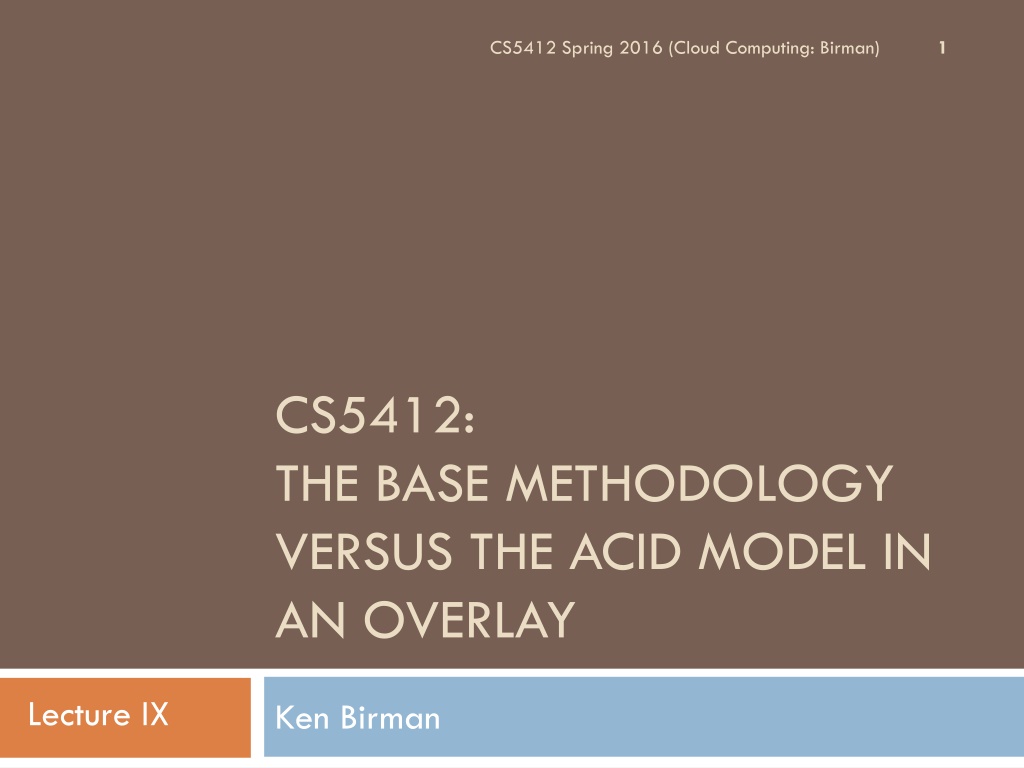
 undefined
undefined



